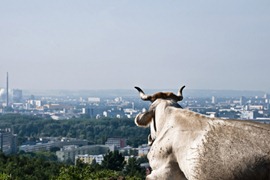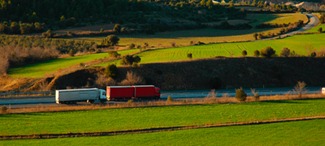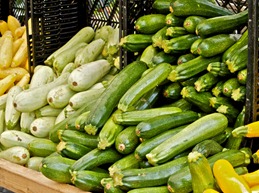The Future of Agriculture is Urban
 The future of farming is urban. Huge cities like New York and Beijing will have vast acres of rooftop greenhouses. Modern metropolises will contain large buildings with architecturally integrated agricultural systems where the inhabitants’ fresh vegetables are grown and poultry and other small food animals are reared. Only staples like corn, wheat and rice, grown on large farms; meat from cattle; ocean fish and regional fruit and vegetables like oranges will still be brought in from distant locations. Food not provided from urban or distant sources will be produced within something like a 50 mile radius around each city.
The future of farming is urban. Huge cities like New York and Beijing will have vast acres of rooftop greenhouses. Modern metropolises will contain large buildings with architecturally integrated agricultural systems where the inhabitants’ fresh vegetables are grown and poultry and other small food animals are reared. Only staples like corn, wheat and rice, grown on large farms; meat from cattle; ocean fish and regional fruit and vegetables like oranges will still be brought in from distant locations. Food not provided from urban or distant sources will be produced within something like a 50 mile radius around each city.
At this point, urban farms are mostly small and experimental or community-based and quaint. But in a world where half the people already live in cities and where 70 per cent will do so by 2050, urban farms will be needed to assure urban food supplies. It’s time to hurry up and make them work.
Inexorably, food supplies will have to move closer to those that are fed. The pressure to do this will come from the incr0easing price of fuel and a growing concern with the carbon pumped into the air  by the trucks, ships and planes that bring our food to us. Currently, most urban American food travels an average of 15oo miles from harvest to table. This sounds far, but when you figure in all the food that is imported — from South America, for instance – the number makes sense. If it travels by truck – and 74 per cent of containerized freight travels by truck in the U.S. – a gallon of fuel is consumed for every 100 pounds transported. If we can produce that food within 50 miles of the city, we cut the fuel per 100 lbs to half an ounce. If we can produce the food within the city, the amount of fuel burned isn’t zero, but it comes darn close.
by the trucks, ships and planes that bring our food to us. Currently, most urban American food travels an average of 15oo miles from harvest to table. This sounds far, but when you figure in all the food that is imported — from South America, for instance – the number makes sense. If it travels by truck – and 74 per cent of containerized freight travels by truck in the U.S. – a gallon of fuel is consumed for every 100 pounds transported. If we can produce that food within 50 miles of the city, we cut the fuel per 100 lbs to half an ounce. If we can produce the food within the city, the amount of fuel burned isn’t zero, but it comes darn close.
Because the scale of most urban farms at this point is small relative to the vast fields deployed for industrial agriculture, urban agriculture is not taken seriously as a national resource. But the possibility of producing significant amounts of food from small individual and community plots was demonstrated during World War II, when the National Victory Garden Program produced 44 per cent of the produce grown in the U.S. during the war years. In Havana, Cuba, they eat well despite the endemic poverty, because 90 per cent of the produce consumed by the city is locally grown.
 A crucial element of urban farming are farmers’ markets. While farmers markets have been around since man began farming, only a few survived into the 20th Century in the U.S and Europe. Most of those, like Les Halles in Paris and New York City’s Essex Street Markets were holdovers from an earlier time when cities were supplied with food by local farmers and not corporate agribusiness conglomerates. Today, there are no modern cities that don’t have many temporary and at least a few established farmers’ markets where people who will pay for superior food crowd the stalls.
A crucial element of urban farming are farmers’ markets. While farmers markets have been around since man began farming, only a few survived into the 20th Century in the U.S and Europe. Most of those, like Les Halles in Paris and New York City’s Essex Street Markets were holdovers from an earlier time when cities were supplied with food by local farmers and not corporate agribusiness conglomerates. Today, there are no modern cities that don’t have many temporary and at least a few established farmers’ markets where people who will pay for superior food crowd the stalls.
Without doubt, agribusiness will end up entering and dominating the provision of urban food, simply because of the scale of the supplies required to feed great cities. But the proximity of supplier and consumer will continue to enable small farmers to fill the many niches the big corporations will inevitably leave unfilled.
Also inevitably, very little of the square footage – or acreage – that will be occupied by urban farms will be on the ground.


